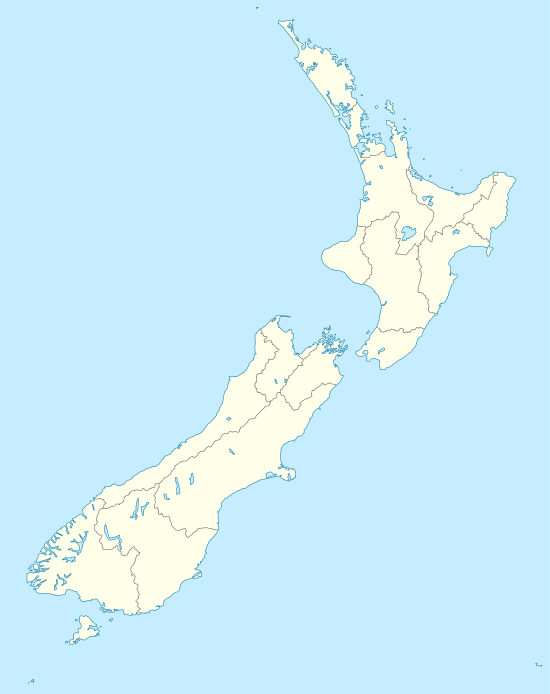Okere Falls
Okere Falls is a small town located 21 km from Rotorua on SH 33 between Rotorua and Tauranga on the North Island of New Zealand. The town is situated on the shore of the Okere Inlet of Lake Rotoiti, from which the Kaituna River flows north towards the Bay of Plenty.
Okere Falls | |
|---|---|
Town | |
.jpg) Kayaker at Okere Falls, with the remains of the powerhouse visible in the lower right | |
 Okere Falls | |
| Coordinates: 38°01′00″S 176°21′00″E | |
| Country | |
| Region | Bay of Plenty |
| Territorial authority | Rotorua District |
| Ward | North |
The New Zealand Ministry for Culture and Heritage gives a translation of "place of drifting" for Ōkere.[1]
Okere Falls is a popular spot for fishing & rafting and is known for its beautiful lakeside and waterfalls. There are commercial rafting companies and holiday park accommodation within the town. A seven-metre-high waterfall lays claim to being the highest commercially rafted waterfall in the world.[2]
The community at Okere Falls is home to a shop, and a school at Wangamarino.[3]
History and culture
The area is the traditional homeland of the Ngāti Pikiao, who remain the guardians of the river through the Lake Rotoiti Scenic Reserves Board.[4] Their traditional name for the Kaituna River was Okere River. The river's alternative name, 'Kaituna', refers to its significance as a food source, in particular eels.
Before the first road bridge over the river was built in 1872, local Māori operated a ferry across the inlet. Travellers from Tauranga to Rotorua would typically break their journey with a night at the nearby Fraser's Hotel.[5]
The first 11 km stretch of the Kaituna River is still commonly referred to as Okere River, and is a site of significant Māori cultural and spiritual values. Okere River means "the place of drifting".
Marae
The area has three Ngāti Pikiao marae:
Economy

The Okere Falls area has drawn visitors for well over 100 years, with the area being a popular day trip destination from Rotorua. By the late 19th century, trout fishing had become very popular, and for a while the hydro-electric power station was a tourist attraction in its own right.[5]
A well-formed bushwalk with scenic lookouts over Okere River and its spectacular waterfalls, the Okere Falls and the Tutea Falls, as well as the remains of the hydro-electric power station, can be found on Trout Pool Road.[2] There are car parks and toilets at both ends of the 30 minute walk, which starts at Okere Falls, passes Tutea Falls about halfway, and finishes at Trout Pool Falls.
At Tutea Falls, named after a local Māori chief, a lookout provides a good vantage point to see kayakers and rafts plunge over the seven-metre-tall waterfall. From the viewing platform, steps lead down to the river and Tutea's Caves. These steps were cut into the cliff face in 1907 as an attraction for early tourists, who would have their photo taken at the bottom of the steps.[8] The trout pool at the northern end of the track is a popular trout fishing spot.
The Okere Falls stretch of the Kaituna River is popular with whitewater rafters and kayakers and is classified as Grade 3/4 and tutea falls being a solid grade 4.
Okere is also home to the Okere Falls Power Station.
In popular culture
In the fifth season of the CBS television series The Amazing Race, Okere Falls were the site of one of two Detour options, 'Clean or Dirty', with teams that chose 'Clean' got the chance to go whitewater river sledging at the falls.
For the second series of Jack Osbourne: Adrenaline Junkie, Jack Osbourne tries whitewater kayaking at the falls as a part of the show's challenge before making his way to Japan.
References
- "1000 Māori place names". New Zealand Ministry for Culture and Heritage. 6 August 2019.
- "Okere Falls Track". Department of Conservation NZ. Retrieved 2014-09-04.
- Whangamarino School
- Information contained on "Whakatauki o Ngāti Pikiao" information panel at the entrance to the Okere Falls track.
- Information contained on "Footsteps of Tourism" information panel at the entrance to the Okere Falls track (DoC).
- "Te Kāhui Māngai directory". tkm.govt.nz. Te Puni Kōkiri.
- "Māori Maps". maorimaps.com. Te Potiki National Trust.
- Information contained on "Descent to the Caves" information panel at Tutea Falls.